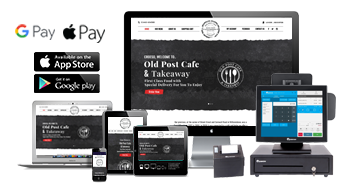"Serving Success: Tackling the Top 5 Hurdles UK Restaurants Conquer"
The UK restaurant industry is a vibrant and dynamic sector, contributing significantly to the economy. However, like any other industry, it faces its share of challenges. From high operating costs to stiff competition, restaurant owners need to navigate these hurdles to ensure their business’s success.

1.High Operating Costs
A. Understanding the Components of Operating Costs
Operating costs in the restaurant business can be daunting. These include rent, utilities, wages, food costs, and more. With the added pressure of supply chain disruptions, these costs have been on the rise, squeezing the margins of restaurant owners.
Diversify your supply chain, consider sourcing locally to reduce dependency on international suppliers. Utilise technology to keep track of your inventory and predict future needs. Online restaurant cost control can also help manage and reduce costs of food.
Platforms like eTakeawayMax offer a zero-commission alternative, allowing you to retain more of your profits. We also provide additional features like loyalty points, discounts, and coupons to encourage repeat business.
B. Strategies to Reduce Operating Costs
1. Streamlining Operations
Streamlining operations can significantly reduce costs. This involves optimizing processes to eliminate waste and increase efficiency. For instance, implementing an online ordering system can reduce the need for extra staff to manage phone orders, thereby reducing labour costs.
Energy costs are a significant part of a restaurant’s operating costs. By implementing energy-saving measures like energy-efficient appliances and LED lighting, restaurants can significantly reduce their energy bills.
2.Staff Recruitment and Retention
A. The Reality of Employee Turnover in the Restaurant management
The restaurant management is notorious for its high employee turnover rates. This can be attributed to the demanding nature of the job, low pay, and lack of benefits. High turnover not only leads to increased recruitment and training costs but also affects the quality of service.
B. Effective Ways to Attract and Retain Staff
1.Offering Competitive Benefits
Offering competitive benefits can attract and retain quality staff. This could include higher wages, flexible schedules, or even opportunities for career advancement.
2.Creating a Positive Work Environment
A positive work environment can significantly reduce staff turnover. This involves treating staff with respect, providing them with the necessary training, and fostering team spirit.
3.Food Waste Management
A. The Impact of Waste on the Environment and Profitability
Food waste is a major issue in the foodservice industry. Not only does it have a significant environmental impact, but it also eats into a UK restaurant’s profits. According to Verdict Food Service, UK restaurants produce 915,400 tones of kitchen waste annually, of which 75% is avoidable.
B. Techniques to Minimise Food Wastage
1. Efficient Inventory Management
Efficient inventory management can significantly reduce waste. This involves tracking your inventory levels accurately, forecasting demand, and ordering supplies accordingly.
2. Innovative Use of Leftover Ingredients
Innovative use of leftover ingredients can also help reduce food wastage. This could involve creating daily specials based on what’s left in the kitchen or even donating excess food to local charities.
4.Stiff Competition
A. The Competitive Landscape of the UK Restaurant Industry
The UK Restaurant is highly competitive, with new establishments opening up all the time. To stand out, restaurants need to offer something unique, whether it’s their menu items, ambiance, or customer service.
B. Standing Out in a Crowded Market
1. Unique Branding Strategies
A unique branding strategy can help a restaurant stand out in a crowded market. This could involve a unique restaurant concept, a distinctive interior design, or even a unique menu.
2. Delivering Exceptional Customer Support
Exceptional customer support can set a restaurant apart from its competitors. This involves not just serving great food, but also creating a memorable dining experience for customers.
5.Adapting to Changing Consumer Preferences
A. The Shift Towards Health-Conscious and Ethical Eating
Consumer preferences are constantly changing, and recently there has been a shift towards health-conscious and ethical eating. This includes a preference for organic, locally sourced, and plant-based options.
B. Catering to the Modern Diner
1.Incorporating Healthy and Sustainable Options in the Menu
To cater to the modern diner, restaurants need to incorporate healthy and sustainable options in their menu. This could involve offering a range of vegetarian and vegan options, using organic ingredients, or even highlighting the origin of their ingredients.
2.Embracing Transparency in Food Sourcing and Preparation
Transparency in food sourcing and preparation is also important to the modern diner. This involves being open about where your ingredients come from and how your food is prepared.
Overcoming Challenges: The Role of Technology
A. How Technology Can Address Customer Problems in Restaurants
Technology can play a significant role in addressing the challenges faced by restaurants. From reducing operating costs to improving customer experience, technology offers a range of solutions for the modern restaurant.
B. Exploring Various Restaurant Technologies
1. Reservation and Ordering Systems
Online reservation and ordering systems can streamline operations, reduce staff workload, and improve customer support.
2. Staff Management Software
Staff management software can help with scheduling, payroll, and even training, thereby reducing labour costs and improving staff retention.
3.Waste Tracking Technology
Waste tracking technology can help restaurants monitor their waste, identify where it’s occurring, and implement strategies to reduce it.
The Role of Social Media in the Foodservice Industry
It has become an indispensable tool for restaurants. It’s not just a platform for advertising but also a channel for engaging with customers and gathering feedback. Helps to enhance their brand visibility, attract new customers, and build restaurant marketing.
1.As a Marketing Tool
Platforms like Facebook, Instagram, and Twitter allow restaurants to reach a wide audience. By posting mouth-watering photos of their dishes, sharing their latest posts, and announcing special offers, restaurants can attract potential customers and drive traffic to their online platforms.
2.Customer Engagement
It provides a platform for restaurants to engage with their customers. This involves responding to customer queries, addressing complaints, and even seeking feedback. By doing so, restaurants can improve their consumer service and build a positive brand image.
Ensuring Food Safety in Restaurants
Food safety is a paramount concern for any UK restaurant. It involves ensuring that the food served is safe to eat and free from any harmful substances. This not only protects the health of the customers but also enhances the restaurant’s reputation.
1. Implementing Measures
Restaurants can ensure safety by implementing various measures. This includes regular cleaning and sanitizing of the kitchen, proper storage of food, and thorough cooking to kill any harmful bacteria. Staff should also be trained on safety practices to prevent any foodborne illnesses.
2. Regular Health Inspections
Regular health inspections can also help. These inspections check for compliance with safety regulations and identify any potential issues that need to be addressed.
Addressing the Issue of Kitchen Waste
As discussed earlier, waste is a major challenge for UK restaurants. However, with the right strategies, restaurants can significantly reduce their waste, save on food costs, and contribute to environmental sustainability.
1. Portion Control
One effective strategy to reduce kitchen waste is portion control. By offering smaller portion sizes, restaurants can reduce the amount of food that gets left uneaten and thrown away.
2. Donating Excess Food
Restaurants can also donate their excess food to local charities. This not only reduces waste but also helps feed those in need.
Challenges Faced by Restaurants Due to Covid-19
The COVID-19 pandemic has had a profound impact on industries worldwide, but perhaps none more so than the restaurant sector. With lockdowns, social distancing measures, and changing consumer behavior, restaurants have faced a multitude of challenges.
Here, we explore some of the challenges and opportunities in the foodservice industry during this unprecedented time.
1. Closure of Dine-In Services
One of the most immediate and visible impacts of the pandemic was the closure of dine-in services. Restaurants, traditionally reliant on in-person dining experiences, were forced to shut their doors to customers. This led to a significant loss of revenue, with many establishments struggling to stay afloat.
2. Transition to Takeout and Delivery
With dine-in services no longer an option, restaurants had to quickly pivot to takeout and delivery. While this allowed some businesses to maintain a revenue stream, it also presented challenges. Not all restaurants were equipped for this transition, lacking the necessary delivery infrastructure or partnerships with delivery platforms.
3. Health and Safety Concerns
The pandemic brought health and safety to the forefront. Restaurants had to implement stringent hygiene practices to ensure the safety of both staff and customers. This included regular sanitization, use of personal protective equipment, and health screenings, all of which added to operational costs.
4. Supply Chain Disruptions
COVID-19 caused significant disruptions to supply chains worldwide. UK Restaurants often faced difficulties sourcing ingredients, leading to menu changes and increased costs. Additionally, fluctuating demand made inventory management a complex task.
5. Staffing Issues
The pandemic also led to staffing issues in the foodservice industry. Many employees were laid off due to reduced business, while others were hesitant to return to work due to health concerns. This left restaurant understaffed and struggling to provide the same level of service.
6. Changing Consumer Behavior
Consumer behavior changed significantly during the pandemic. Many customers shifted towards home cooking or opted for contactless delivery options. This change in dining habits posed yet another challenge for restaurants trying to attract customers back to their establishments.
Conclusion
The UK restaurant industry, like many others, faces its unique set of challenges. From grappling with the ever-evolving consumer preferences to navigating the complexities of staffing, restaurant owners and managers must be agile and innovative.
In the modern restaurant landscape, having a well-designed and functional website has become an indispensable asset for establishments looking to succeed and thrive. A restaurant website serves as the digital storefront, providing customers with crucial information, enticing visuals, and an opportunity to engage with the brand.
With every challenge comes an opportunity. By embracing technology, fostering a culture of continuous learning, and prioritizing customer experience, UK restaurants can not only overcome these hurdles but also thrive in an increasingly competitive market. As the industry continues to evolve, those who adapt, innovate, and remain resilient will undoubtedly lead the way, setting new standards for excellence in the culinary world.








